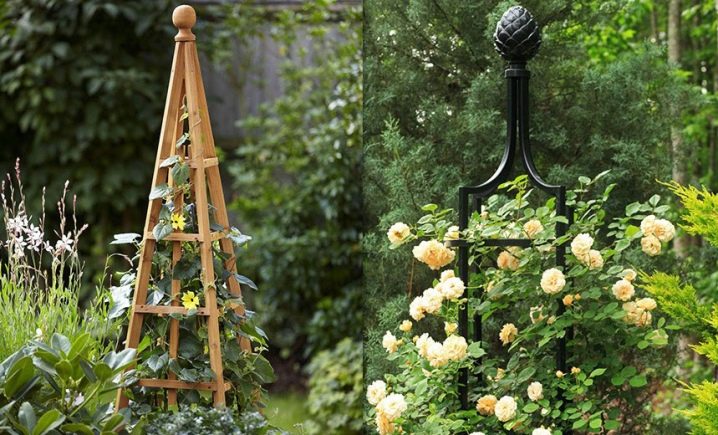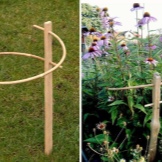Types and characteristics of flower supports

Every gardener knows that in order for flowers to look well-groomed and beautiful, they must be properly grown. This applies to both indoor and garden flowers. In both cases, most flowers need good support for normal development.

Peculiarities
For those who are not at all versed in gardening art, first you need to understand what supports now exist and what are their features and differences from each other.

Metal structures
Most often, metal, metal nets and arches are used to create strong supports, they are loved for their practicality. They can be attached to a fence or wall, or simply fixed next to the flower. The most common type of such an attachment is a metal mesh. It can be found in any specialty store. After installation, these "metal scales" seem ugly and even spoil the appearance of the garden. But as soon as the first greenery and flowers appear, all this beauty immediately hides the grid.
There is one more important feature of such supports. With a welding machine and a bit of talent, a simple metal mesh can be turned into an arch or an elegant gazebo.
In addition to nets, metal products such as pipes or wire are also popular with gardeners. If the material was previously used, then it must be sanded, primed, painted. Typically, these columns are painted white, black or green.



Plastic
The plastic construction will also work for support. The main feature of this material is that it is very lightweight and practical. Even a person who has never held garden tools in his life can cope with the installation of plastic support. Another plus of this material is that it can be decorated.
The easiest way is to decorate the plastic base with a layer of moss. In this case, the garden will look beautiful until winter.



Wooden supports
The main advantage of wood is that it is an environmentally friendly material. In addition, if the tree is young, then the support will turn out to be strong and will stand for more than one year. To support the flowers, you can simply install small posts and create a small fence along which green shoots will trail. The constructions of the original form look especially interesting. For example, a fence consisting of boards of different lengths, or a fence woven "antique". To work with wood, you only need boards and strong nails.




Bamboo props
Special attention should be paid to such material as bamboo. It is lighter than regular wood, but no less durable. Bamboo supports are used to support climbing plants. Bamboo props are best suited for plants such as vines, clematis, and some types of roses. Against the background of the bamboo base, their green foliage looks incredibly beautiful.


Coconut
Another non-standard type of flower support is coconut. Its main feature is that it is as strong as possible. Coconut structures are usually used to form some kind of large flowers or bushes. This option is good both for plants in floor tubs and for garden flowers. It takes a little work to create the coconut support.
It is based on a simple wooden stick, which is covered with metal wire and decorated with coconut fiber for strength. It is not surprising that such a structure is capable of supporting even the largest weight of the "green friend". You can buy coke fiber at any gardening store. All varieties of flower props are good in their own way. Therefore, when choosing an option for your garden, you need to look at the features of each subspecies.


Support requirements
There are only a few simple requirements for flower props.
The main point is strength and reliability. No matter how beautiful the support may be, if it breaks during the first thunderstorm, then the choice was definitely made incorrectly.
It is important to understand for which plant the support is being purchased. It must be able to support his weight. In addition, the support should be high enough so that even an adult plant can be fixed well on it.
And only in the last place is it worth paying attention to external attractiveness. It is worth choosing a support depending on the style in which the garden is decorated. For a small Japanese garden, bamboo props are suitable, but for a platform decorated in a classic style, it is better to choose exquisite metal columns decorated with forged inserts.


Views
All existing supports can be divided into two main types.
Decorative
This design is in itself a real decoration of the garden. You can even do without flowers. Thanks to the forged product, the garden will look like a fabulous meadow next to the castle. And if you also pick up a beautiful flower for it, you get a truly delightful composition. This type of support includes arches, pergolas, nets, and garden screens. The latter deserve special attention, because they are decorated with turrets and sculptures, which makes a simple support look like a piece of architectural art.



Technical
As the name implies, these props perform only their main function - they support the plants so that they do not fall. The technical ones include props such as wire or mesh. However, this division is conditional. Modern nets look so beautiful that they can easily decorate any garden with them.


There is another way to classify existing props. In this case, they already look at which plants are supported.
Supports for indoor plants
Inexperienced gardeners often find that houseplants don't need props and that flowers will grow beautifully on their own. But in fact, indoor flowers also need props. This is especially true for plants with large leaves or long stems. For indoor flowers, props made of metal-plastic, plastic or thin wood are usually chosen. For example, next to an orchid or green tree, a thin bamboo stick tied with twine or decorated with moss looks great. In specialized stores, you can pick up supports of any height, diameter and strength. This means that you can fix the plant in pots, and in flowerpots, and in pots.


For garden plants
Garden plants make the yard more comfortable. The same can be said for properly sized props. This design (regardless of whether it is round or conical) gives the flowers a shape and allows you to control their growth. Supports made of natural material look most natural in the garden. These can be wooden props or even stones found in the garden.
Such props can be conditionally divided into two more subspecies: artificial (man-made wooden fences, polished props in the form of a cone) and natural (branches of nearby bushes or trees, pebbles). Unlike a small house or apartment, the garden really has space and possibilities. There is no need to limit your imagination to one pot with an orchid.You can build a base in the form of arches, gazebos, or even create whole walls, entwined with ivy or roses.


For garden plants, it is very important to select a support so that it does not harm its development.
If the plant winds upwards, then it is better to install high pillars or a metal wall next to it. This works well for lemongrass, hops, or honeysuckle. Plants such as the climbing rose need a large-mesh support. It is also stretched horizontally. If the plant has antennae (this group includes ivy, hydrangea, maiden grapes), then it will trail on any surface. The main thing is that it is rough and the antennae on it can be securely fixed. But for plants such as princes, cucumbers, asparagus beans, you need a lot of free space. Therefore, wide grids should be installed next to them as a support.


For horticultural crops
The so-called beneficial plants also need support. A well-chosen support will not only turn a regular tomato bush into a part of a larger garden, but will also increase the yield. For growing horticultural crops, not only simple arches or pergolas are suitable, but also a kind of mini-greenhouses. In this case, the support is the main wall. If necessary, it is supplemented with metal nets or rope bindings. For growing tomatoes, asparagus, beans or cucumbers, the same coconut support made of durable fiber is suitable.
When decorating a garden or growing indoor flowers, you can use several types of supports at once - the main thing is that all elements of individual structures are combined with each other.
In this case, the site or room will definitely look aesthetically pleasing.

Subtleties of choice
It does not matter if a support is selected for indoor flowers in pots, garden plants, home crops or climbing vines, the purchase and installation process must be taken with the utmost responsibility. Here is a list of the main points that experienced gardeners pay attention to when choosing the next support.
- Height. The tall plant holder is not suitable for small flowers that hang on the ground. These props are designed exclusively for growth flowers.
- Width. If a flower needs a lot of space for growth, then you should immediately take a support in the form of a grid or a fence. Small posts made of metal or wood are perfect for single plants.
- Strength. Before buying a support, you need to carefully study on the Internet all the information about the colors that it will hold. It is worth finding out to what size and weight they grow. Depending on this, more fragile or, conversely, strong supports are chosen.

If the store did not find a suitable support, then the holding structure can be made even with your own hands. There are many options. It can be a regular plastic or metal pipe painted a bright color, a wooden board, or even a mesh fence. The material is selected all according to the same principle. It should be fairly solid and fit the overall composition. A support for flowers is a guarantee that the plant will definitely be healthy and the garden will be beautiful. Knowing how to choose the right supports, everyone can become a competent gardener.
See the following video for how to choose simple supports for flowers and plants.













The comment was sent successfully.